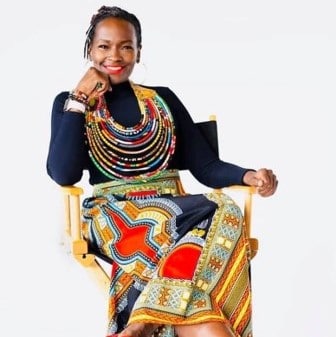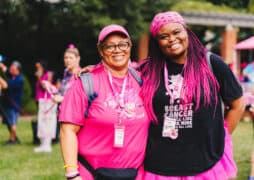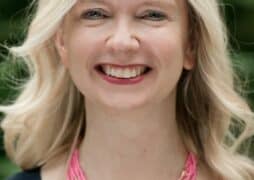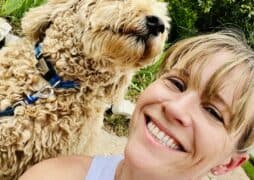Periodically throughout the year, Walgreens customers have the ability to donate at checkout to Susan G. Komen and The Leukemia & Lymphoma Society (LLS). It’s hard to imagine that giving a small amount at the cash register can make a real impact, but for the very real people living with breast cancer, that impact equates to real research, real support and real hope.
To honor these patients and support the work of Komen and LLS, Walgreens is sharing first-person accounts that demonstrate how we play a vital role in the lives of those affected by cancer. The following story first appeared on Walgreens News.
Tawana’s story: “The research that Susan G. Komen supports is the reason why I am standing here today.”
Reverend Tawana Davis has been living with stage IV, metastatic HER2 positive breast cancer since November of 2016. Since her diagnosis, she has endured several surgeries, hospital stays and near-fatal experiences, but remains committed to advocating for and supporting others touched by breast cancer. This is her story.
I was 23 years old when my mother died from complications of multiple myeloma, which is cancer of the bone marrow. I’ve always been surrounded by cancer survivors, which may have been a way for me to reconcile my own mother’s death. I felt like my mom really didn’t get to live with cancer, she was dying from it. And I wanted to shift that narrative, where cancer doesn’t equate to death. In my own community, oftentimes we call it the “big C,” we don’t even want to say the word, because cancer equals death in our minds. So, it meant a lot to me to serve and volunteer and help breast cancer survivors on their journey, which is something that I did for many years.
I had no idea that I would be diagnosed with the very same disease that I’d been advocating and raising awareness for, but in November 2016, I found a swollen lymph node under my left arm and was diagnosed with breast cancer. It had already metastasized, which was a term that I didn’t know at the onset of my diagnosis. It meant that my cancer had already spread beyond my breast, but all I knew was that I was diagnosed with breast cancer, had two tumors in two different quadrants of my left breast, and a lymph node that was cancerous, which meant that I needed a mastectomy.
I chose to have a bilateral mastectomy because since it had already spread, I did not want to wait for it to spread to my right breast. First, I had six rounds of grueling chemotherapy to shrink the tumors, where I lost all of my hair and lost a tremendous amount of weight, couldn’t take care of myself and couldn’t drive. My daughter took a job where she had the flexibility to be my caregiver and take me to every doctor’s appointment. Then I had a bilateral mastectomy, removing the two tumors and six lymph nodes.
I waited six weeks and I was supposed to start radiation. I went in for radiation scanning and my oncologist said, “Tawana, didn’t you just have surgery?” I told her, “yes, that’s why I’m here. The plan was chemo, surgery, radiation.”
She said, “All of your cancer is back.”
I’d had a very aggressive recurrence, and the doctors weren’t sure what to do. They said they could go back in and do surgery again, but it would leave me with some debilitation on my left side. My plastic surgeon suggested getting another opinion on how to address the recurrence, so I did. That’s how I was introduced to immunotherapy.
There was a local clinical trial I qualified for, so I switched doctors and started on immunotherapy for about a year. During that year, I had another recurrence. Somehow a piece of the breast tissue and the tumor escaped the protective quadrant. At that point, we decided to stop the immunotherapy because it was sending my organs into overdrive – my liver, my kidney, my spleen. It was supposed to be this breakthrough medicine, and it worked for a year, but ultimately didn’t work for me.
After I came off immunotherapy, I had surgery to remove the new tumor. I will continue treatment via infusion every three weeks, indefinitely. That is where we are now. That’s where my life stands. It’s not as grueling as the first six rounds of chemo – I’m up, I can drive. I take my grandson to school and pick him up every day. Fatigue is tough, but diet and exercise help to combat that a bit.
I’ll be in treatment for the rest of my life. Do I get frustrated? Absolutely. Do I cry? Absolutely. Do I wonder how this is going to end? Absolutely. And then I check myself and I realize that I have another day to watch the sunrise. I have another day to take my grandson to school, and just watch his beautiful smile and beautiful spirit when he comes into the car to greet me.

The Susan G. Komen breast cancer Walk back in September was the first walk that I was able to do. Before that I couldn’t be around people because of my compromised immune system, and I couldn’t even stand for long periods of time. So that moment meant so much to me, to be around all these people caring about the cause, whether they were diagnosed, a caregiver, a family member, or just someone who knows someone with breast cancer. Just being around all of that healing, powerful energy was amazing.
That experience just affirmed that this is what I’m supposed to do. I’m supposed to tell my story and share with folks, this is what being diagnosed with breast cancer is like, but I am not my diagnosis. I have an opportunity to change the narrative. I can encourage others to live their best lives, show them that they can still find beauty in these moments. There are learning opportunities, there are growth opportunities, there are divine opportunities… there are miracles that still happen. Even in the midst of diagnosis.
One thing I’ve learned is that there’s a language barrier we all face when we’re trying to support a cancer patient or their caregivers. There’s a challenge with putting a language to what we are feeling, and then being okay with feeling that way, so then we end up saying kind of quirky things. I think introducing a language that is very specific: I feel you; I see you. How can I be supportive of you as the person with cancer, as the daughter, as the son, as the caregiver, as the mom witnessing her child going through this? Can I come and sit with you? May I start a meal train?
Now, let us not promise the world and then we can’t deliver, because then that’s one more disappointment. You can be specific in a way that honors who you are and what you’re capable of, and name how and in what capacity you can offer support. That might be giving a supermarket gift card so that the family of the person with cancer can buy healthy groceries, or even arranging to have groceries delivered to them.
It’s the same thing when it comes to donating to causes like Komen. While we all want to save the world, we just can’t. It’s about picking your causes and doing the best you can. If your best is $5 at the checkout counter and that’s your sacrifice, honor that and wear it proudly and know that you have sown a seed toward saving someone’s life. Because the research that Komen supports is the reason why I am standing here today, alive. I want everyone who donates to know that no matter how big or how small the amount, their donation will help identify how we can better fight this huge, disrespectful beast called cancer.
This piece originally appeared on the Walgreeens Newsroom



